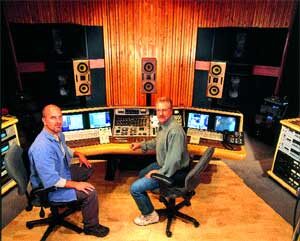 As part of its Pioneer Classics series, Pioneer Entertainment is releasing works by Beethoven, Verdi, Wagner, and other composers on DVD-Video with remastered surround sound tracks. For Verdi’s Requiem, Pioneer tapped L.A.-based Media Hyperium, Inc. to produce the DVD. Herbert Waltl, Media Hyperium’s president, in turn, called on Future Disc System’s Steve Hall to remaster the original stereo recording for 5.1 release.
As part of its Pioneer Classics series, Pioneer Entertainment is releasing works by Beethoven, Verdi, Wagner, and other composers on DVD-Video with remastered surround sound tracks. For Verdi’s Requiem, Pioneer tapped L.A.-based Media Hyperium, Inc. to produce the DVD. Herbert Waltl, Media Hyperium’s president, in turn, called on Future Disc System’s Steve Hall to remaster the original stereo recording for 5.1 release.
Verdi’s Requiem is one of the most well-known classical compositions for orchestra, chorus, and vocal soloists. Frankfurt’s Alte Oper, one of Europe’s premiere concert halls, was the site of the 1990 concert recorded in a multi-camera shoot.
�The original source tape was a Digital Betacam with 16-bit, 48 kHz 2-channel audio track,� states Hall. �The first thing I did was to view the video and listen carefully to the recording while transferring it into my Sonic Solutions system. At that point, I started to formulate a plan to expand what was there on the stereo master. The hall itself had a nice even decay, so, by working with delays, I was able to enhance the original recording’s decays and re-create a surround ambience.�
Hall cleaned up the original audio with the No Noise functions of the Sonic system, then transferred and up-sampled the Sonic’s output via a Pacific Microsonics HDCD converter at 24/96. The program was then converted to analog and fed into an AGM TSS-1. The TSS-1 accepts an analog stereo input and provides a left, center, and right output.
�The AGM’s a great box in that it widens the left and right image and creates a reasonable center channel. I’ve found this method to be much more accurate than other methods using phase reversal or multing of the original stereo mix,� says Hall. �It creates a wider sweet spot to allow better 5.1 reproduction in homes, since many home theater speaker systems are not set up symmetrically due to space or installation limitations.�
For classical recordings such as the Verdi, Hall uses the TC 6000 to create additional space and ambience that he then feeds to the left and right surround. He carefully shifts the time and directionality of non-musical elements such as the applause into the surrounds. �That way, the listener is still getting the majority of his auditory cues from the L-C-R speakers, but the position of the listener in the hall, as well as the hall’s size and geometry, can be re-created. When and where the applause begins gives a listener his/her auditory reference. It takes a bit of experimentation, but the results are believable.�
Verdi took full advantage of the tremendous dynamic range that orchestra, 80-voice choir, and four soloists produce. By careful filtering, Hall created a LFE track for this project, but rather than simply sending some of the original low-frequency program to the subwoofer, he prefers to add weight and size to the acoustic environment, in this case, the wonderful sounding Alte Oper venue. �For classical recordings, even one as dramatic as the Requiem, a little goes a long way when it comes to LFE,� advises Hall.
Now that Hall had a 6-channel version he was happy with, it was time to master it for DVD-Video. First he ran the 6-channel output of his Sonic system into a Dolby DP569 encoder to create a Dolby Digital bit stream. At the same time, he made an uncompressed stereo version of the newly restored audio for inclusion on the final disc. �I check the 5.1 Dolby Digital and the Dolby Surround (4.0) versions, as well as 2-channel and mono playback ones, to make sure that the music will translate acceptably, no matter what type of speaker setup the listener has.�
Future Disc is now offering complete DVD authoring, so Hall’s colleague, Dave Conrad, then married Hall’s digital audio files with the MPEG-encoded video in Future Disc’s DVD authoring suite in close consultation with project producer, Herbert Waltl. At that point, a reference DVD-R is burned that includes the new audio, remastered video, and the liner notes. On Verdi’s Requiem, these include bios of the conductor and soloists, plus the orchestra’s and chorus’ respective histories. The DVD also features a �music analysis� feature with either Latin or English lyrics displayed on screen.
Once the DVD-R was approved, then the project is mixed to DLT and sent to Pioneer’s replication facility.
�About half of the surround work we’re doing now is re-purposing recordings that are in the can,� Hall concludes. �An incredibly convincing multichannel mix can be created for DVD if the original recordings are carefully analyzed and processed correctly. On some of the rock and pop DVD-Audio projects that I’ve been mastering, there’s some very creative use of the 6-channel soundfield. The original artists and producers are excited to hear their tracks come to life in this new format. I’m looking forward to working on some new tracks that have been conceived and recorded in surround, but in the here and now, there’s no shortage of great music like the Verdi Requiem that can benefit from a new 5.1 version.�


